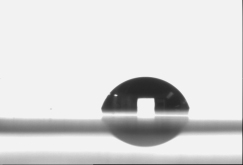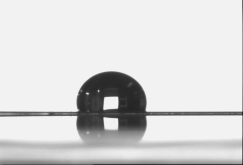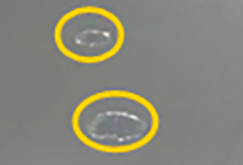- HOME
- Products
- Release papers and films
- Product construction
- Little-silicone release agents
Little-silicone release agents. Their demand is increasing especially for electronic devices where silicone can be detrimental. The features and physical properties of LINTEC’s little-silicone release agents are shown below.
Features
- Ideal surface tension that ensures superior resin coatability (water drop contact angle, θ = 70° - 105°)
- High resin coatability (leveling property) and separatability, realizing uniform release performance and improved productivity.
- Available in various formulations with a wide range of release forces from light to heavy release.
Resin coatability test
- The contact angle was measured after dropping 2 µl of pure water on a surface treated with release agent.
【Little-silicone release agents】

【Silicone release agents】

- Epoxy resin (10-µm thickness) was applied to a surface treated with release agent, and the surface was checked for repelling and coating unevenness.
【Little-silicone release agents】

High surface tension and superior resin coatability reduce the chance of repelling or coating unevenness.
【Silicone release agents】

Low surface tension and inferior resin coatability increase the chance of repelling and coating unevenness.
Physical properties of the representative little-silicone
| Name of release agents | Release force*1(mN/20mm) | Contact angle*2(°) | The surface free energy*3(mJ/㎡) | ||
|---|---|---|---|---|---|
| Pure water | DMF | Cyclohexanone | |||
| 6040 | 95 | 102 | 58 | 47 | 24 |
| X | 550 | 96 | 44 | 19 | 30 |
| AL-5 | 1850 | 94 | 46 | 23 | 35 |
| 6501 | 3300 | 89 | 35 | 20 | 37 |
| T157 | 5500 | 73 | 20 | 5 | 45 |
| T157-2 | 6000 | 73 | 16 | 5 | 46 |
| Polyester film | 7700 | 57 | - | - | 47 |
| Polyethylens laminate paper | 2000 | 95 | 29 | 14 | 36 |
| Polypropylen laminate paper | 3700 | 104 | 43 | 33 | 28 |
- Above figures are measured values; they are not guaranteed.
- Includes those containing a trace amount of silicone.
- *1Acrylic adhesive tape “31B” (Nitto Denko Co.) was attached using a 2-kg roller onto a surface treated with release agent, and the release force was measured 30 minutes later (tape peel; 180-degree peeling at a rate of 0.3 m/min).
- *22µl of solvent was dropped onto a surface treated with release agent, and the static contact angle was measured.
- *3The surface free energy was calculated from the contact angles of pure water, 1-bromonaphthalene and diiodomethane.
Contact Us
For product inquiries, please use the entry form or contact the following address.
- LINTEC Corporation Converted Products Operations
- PHONE: +81-3-3868-7721
FAX: +81-3-3868-7728
8th Fl., Bunkyo Garden Gate Tower, 1-1-1 Koishikawa, Bunkyo-ku, Tokyo 112-0002, Japan